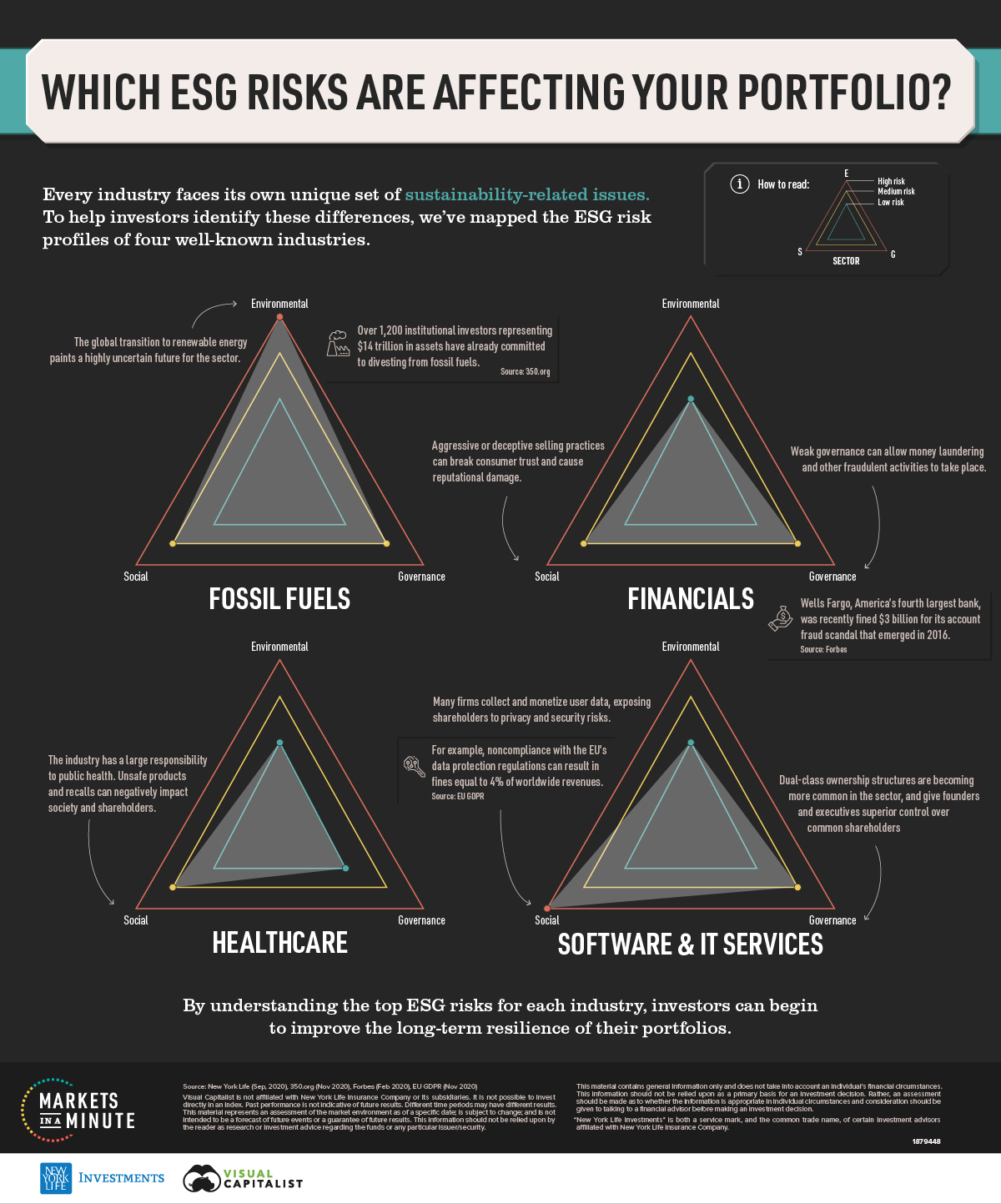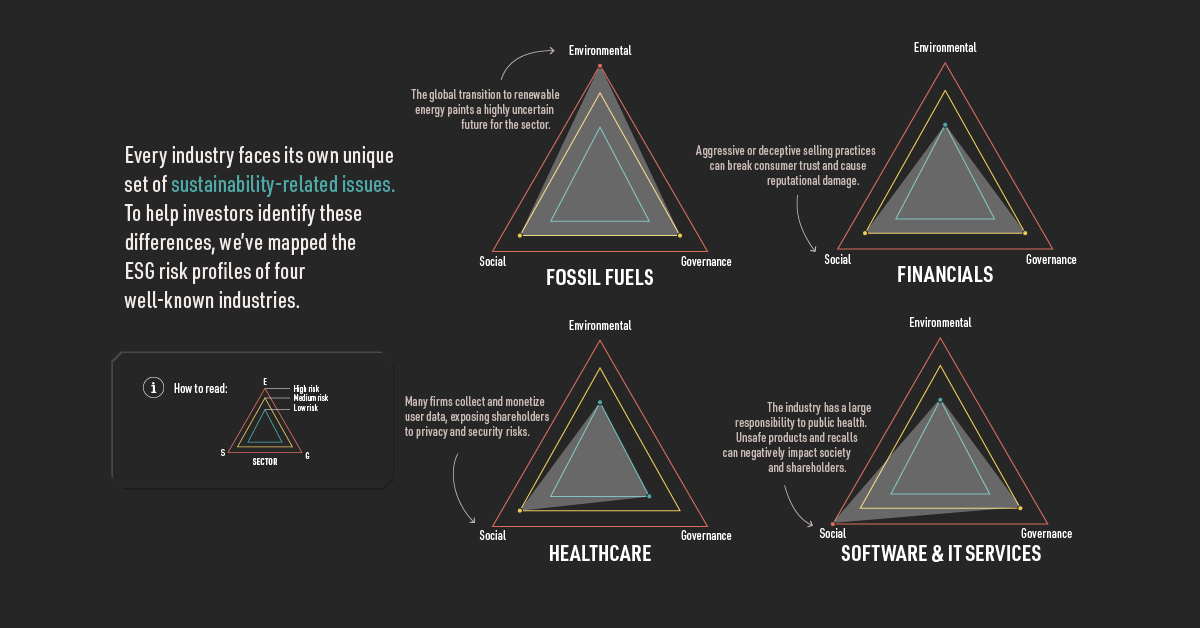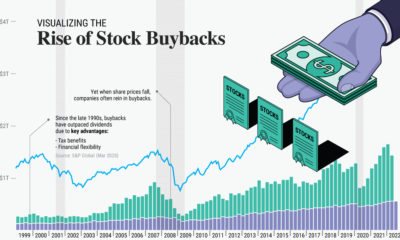Visualizing ESG Risk by Industry
Aging populations, climate change, and data security are some of the world’s most pressing issues, but what theme do they all share? For investors, the answer is certain: sustainability.
Sustainability is a concept that’s quickly moved into the mainstream, and is best described as the consideration of environmental, social, and governance (ESG) factors when analyzing companies. Combining these non-financial metrics with traditional analysis has been proven to have a positive influence on long-term returns.
In this Markets in a Minute chart from New York Life Investments, we’ve mapped the ESG risk profiles of four prominent industries to gain a better understanding of the sustainability issues they’re likely facing.
Fossil Fuels
Investors in this sector have substantial exposure to all three ESG risks, with environmental issues being the most significant.
| Risk | Importance | Issues to Consider |
Environmental |
High | - The global transition to green energy
- Stricter environmental regulations
- Harm from spills and other accidents
|
Social |
Medium | - Strained community relations
- Shifting consumer attitudes
|
Governance |
Medium | - Shareholder transparency
- Risk management structure
|
The global transition to renewable energy paints a complex future for the sector, though it’s uncertain when oil demand will peak—predictions range from 2025 all the way to 2040. Nevertheless, market participants are taking action. To date, over 1,200 institutional investors representing $14 trillion in assets have made commitments to divest from fossil fuels.
Social risks are another source of uncertainty, especially as public awareness around climate change increases. A planned expansion of the Keystone Pipeline System, referred to as Keystone XL, has faced nearly a decade of public resistance and currently remains blocked by the U.S. Supreme Court.
Last but not least are governance risks. With many investors considering the switch to a fossil fuel-free portfolio, shareholder transparency will be of utmost importance. The onus will be on company management to demonstrate that they have a clear understanding of the risks and opportunities ahead. Royal Dutch Shell, the world’s fourth largest oil company, has made progress on this front by announcing its strategy for achieving net-zero emissions by 2050.
Financials
Social and governance risks are the top priorities for investors in the financial sector. Firms that finance the fossil fuel industry may have indirect exposure to environmental risks.
| Risk | Importance | Issues to Consider |
Environmental |
Low | - Indirect exposure to the fossil fuel industry
|
Social |
Medium | - Aggressive or deceptive selling practices
- Client relations
|
Governance |
Medium | - Corporate governance
- Executive compensation
|
Underpinning the strength of the financial sector is consumer trust and client service. By using aggressive or deceptive selling practices, firms risk severe reputational damage and even financial penalties. Wells Fargo, America’s fourth largest bank, was recently fined $3 billion for its account fraud scandal that emerged in 2016.
These issues are closely related to governance risks, where weak internal structures can allow fraudulent activities like money laundering to take place. In fact, over a 15 month period ending in 2019, global banks were fined $10 billion for engaging in the activity. Experts believe that 60% of laundering fines resulted from criminals slipping past screening systems.
Healthcare
Social risks are the top concern for healthcare investors, given the sector’s important role in public health and well-being.
| Risk | Importance | Issues to Consider |
Environmental |
Low | |
Social |
Medium | - Product safety and recalls
- Inappropriate or misleading marketing
|
Governance |
Low | |
Unsafe products are one the most clear-cut issues because they directly harm society and shareholders. Johnson & Johnson, one of the world’s largest healthcare companies, has faced thousands of lawsuits for failing to warn consumers about asbestos in its baby powder products. The company was recently ordered to pay $2.1 billion in damages by a Missouri appeals court.
The use of inappropriate advertising is another issue that investors may want to watch out for. In 2019, Mundipharma was fined by the Australian government for making inaccurate statements in its marketing materials for opioids.
Software & IT Services
Companies in this sector are exposed to various social and governance risks, but are not known to be large polluters.
| Risk | Importance | Issues to Consider |
Environmental |
Low | - Operation of data centers
|
Social |
High | - User privacy
- Data security
|
Governance |
Medium | - Shareholder structure
- Antitrust disputes
|
Many firms in this industry collect and monetize user data, exposing their shareholders to data privacy and security risks. Facebook has been at the center of numerous controversies in recent years, including the Cambridge Analytica scandal, which saw the unconsented collection of personal data from 87 million users. Polls found that 44% of Facebook users viewed the platform more negatively after the scandal.
These risks are likely to be amplified as governments take a firmer stance on data regulation. In 2018, the EU implemented its General Data Protection Regulation (GDPR), one of the world’s toughest privacy and security laws. In certain cases, noncompliance with the GDPR can result in fines equal to 4% of a company’s global revenues.
Navigating an Uncertain Future
Global sustainability issues are creating a more challenging environment for businesses in all types of industries. To hedge these risks, investors are turning to ESG in massive numbers—the value of sustainably managed assets now sits at $40.5 trillion, nearly double the amount from four years ago.
It’s important to remember, however, that businesses are unique. A social issue affecting one industry may not be as relevant for another. When armed with this knowledge, investors will be able to make more informed decisions that strengthen the long-term resiliency of their portfolios.




 Infographics2 years ago
Infographics2 years ago
 Markets in a Minute2 years ago
Markets in a Minute2 years ago
 Markets in a Minute2 years ago
Markets in a Minute2 years ago
 Infographics2 years ago
Infographics2 years ago
 Markets in a Minute1 year ago
Markets in a Minute1 year ago
 Infographics3 years ago
Infographics3 years ago
 Markets in a Minute2 years ago
Markets in a Minute2 years ago
 Infographics1 year ago
Infographics1 year ago




















